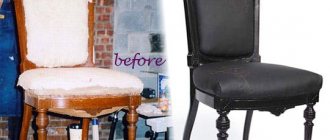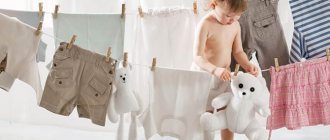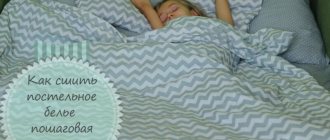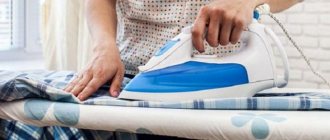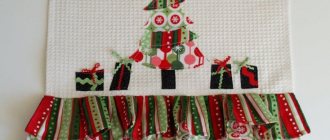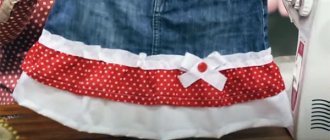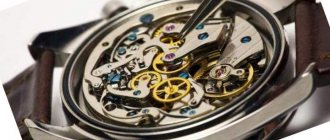A large number of young parents are interested in the question: how to sew children's bedding. Or maybe the best option is to buy baby underwear in a store? To determine which is better, you need to compare the pros and cons of each side. Of course, the price of a complete set of linen is higher than linen purchased separately. However, sewing takes a lot of effort and time, which is already not enough.
The advantage of doing it yourself is that the mother herself will choose the appropriate material of good quality and color, and the process, although it will take some time, is not difficult even for beginners. Today we will look at how to sew a kit for a newborn’s crib with your own hands.
Sewing your own underwear is interesting not only for the mother, but also for the child
Choosing the right fabric
If you make the choice yourself, then you need to consider only high-quality fabric, preferably of natural origin. You should choose only those types of materials that have the following qualities:
- Hypoallergenic;
- Environmental cleanliness;
- Increased comfort;
- Air permeability;
- Easy to wash and care.
The set must meet all quality standards.
The best option is 100% cotton fabric. Bedding made from it is suitable for any season: summer and winter. There are the following classes of cotton fabrics, differing from each other in the type of weaving of the threads:
- Calico. It is hypoallergenic, breathable in both directions and has high wear resistance, but is rougher to the touch than other types and requires proper washing or it will begin to fade;
- Chintz. The material is natural and pleasant to the touch. It is also highly breathable, but unlike calico, it does not require special care. Its disadvantage is rapid wear and loss of brightness (color) over time. Ideal for children immediately after discharge from the hospital;
- Satin. It has excellent wear resistance, does not electrify and does not wrinkle. In addition, satin retains its appearance after repeated washings and transfers heat well. It has no distinctive disadvantages;
- Poplin. Excellent air permeability and evaporation of moisture, easy to wash and does not accumulate static electricity. It has virtually no negative qualities, but can shrink when washed in hot water;
- Bamboo. It has high strength and antimicrobial action. Excellently absorbs moisture and odors. The downside is the high cost;
- Flannel. Soft to the touch and becomes even softer after washing. Quickly retains heat and does not cause allergic reactions. Disadvantage: formation of pellets over time, as well as severe creasing.
You might be interested in this: The procedure for creating darts for a dress on the back and chest
Cotton is an ideal material for children's underwear
Materials
First of all, we need to decide what we will use to create children's bedding. For kids, the ideal option is cotton. It is pleasant to the body, leads in breathability and hygroscopicity, does not electrify, does not cause allergies or irritation and, most importantly, is easy to care for and can even withstand boiling.
Types of cotton fabrics:
- Calico is the most popular type of material among industrial manufacturers. Available in a density of 110-145 g/m2, the optimal thickness is 120. The smoothness of calico varies greatly, it must be assessed by touch. The weave is quite loose, so it conducts air and removes moisture better than others.
- Poplin is a competitor to calico that is rapidly gaining fans. It differs in that it consists of thin warp threads and thick weft threads, so that the fabric is opaque to light, more flexible, flowing, and lighter. Available in different thicknesses, but the optimal surface density is 115-120 g/m2.
- Satin is a material that is smooth almost like satin, due to the fact that the weft comes to the surface through 4-5 warp threads. The canvas is very dense both to the touch and to light through, the optimal thickness is 120 g/m2 for regular and about 200 for jacquard.
Important! Do not take chintz under any circumstances: it is too thin and the threads are twisted too poorly; such a set will lose its attractiveness after a couple of washes.
Personally, I recommend taking poplin if you are afraid that the slight roughness of calico will be unpleasant for your baby. There is no point in overpaying for satin, especially since it requires gentle washing so that the fabric does not lose its shine.
Sizes and measurements
With measurements of linen everything is simple, as for adults; for children there is a classification of linen into single, single and double. It is sewn in two standards: European and Russian. Children's bedding should be sewn based on their height and their own preferences. In general, the standard defines the following sizes for children:
- Duvet cover - 110 - 120 centimeters by 140-150 centimeters;
- Sheet - 100-120 centimeters by 138-160 centimeters;
- Pillowcases - 40 by 60 centimeters.
Important! A children's set differs from an adult's not only in size, but also sometimes in its contents. One of the features is the presence of elastic bands that secure the sheet to the mattress. This prevents the sheets from becoming wrinkled in the morning and ensures better quality sleep for your baby, who often tosses and turns at night.
size table
Quantity of material
Before purchasing fabric, we recommend that you take accurate measurements of the pillow, blanket and mattress, since individual sizes of children's bedding often differ from the standard ones. After measuring, add 7-10 cm in length and width. Approximately this amount is needed for processing seams, eliminating fabric unevenness and shrinkage.
Factory fabric rolls come in different widths. To make a children's set, there is enough material 150 cm wide.
The standard size of a baby sheet is 110 by 140 cm, so you will need a piece 150 cm wide and 120 cm long.
Fabric consumption when sewing
In order to purchase exactly the amount of fabric needed for sewing, and not make a mistake in the sizes, you need to measure each attribute:
- pillow;
- Blanket;
- Mattress;
- Bed.
You can measure the laundry you already have to save even more. You can calculate using standard sizes without running around the house with a ruler using the size numbers indicated in the previous section. You should also take into account that the canvas needs to be purchased 10 or 15 cm more than required. The fabric often “shrinks” and when sewing it may be necessary to make the product a couple of centimeters longer.
An example of cutting children's bedding
How to choose quality fabric for bed linen
But what you absolutely don’t need to save on is choosing high-quality fabric.
- In order to sew practical sleepwear, you need to choose 100% cotton fabric and then it will please mother and child for a long time. Fabrics such as calico, satin, and chintz are perfect for this.
- When choosing and purchasing fabric for sewing a bedding for a crib, you need to pay attention to the density indicated on the label that is on each roll of fabric. Ideally, the density should be 128 g. and a meter higher, such fabric can be safely purchased for sewing children's products. In general, in order not to spend money on a counterfeit cheap product, before purchasing it is necessary to carefully study the composition of the material, which must be indicated on the labels.
- The quality and durability of the bedding set also depends on the threads used for sewing: they need to be highly durable and at the same time not very thick. When using high quality threads, you can be sure that the seams will not come apart and the product will not tear.
So, the material that meets all the requirements has been selected, what next? Of course - an exact calculation.
How to sew bedding for a crib with your own hands
Before you start sewing, you need to prepare all the necessary tools:
- Fabric, the width of which will be from one and a half meters with a length of four meters;
- Dense material for sides;
- Thread and needle;
- Sewing machine;
- Scissors and pins;
- Tape and ruler;
- Crayons or remnants;
- Foam rubber and iron.
In addition, you need a good mood and free time. The work done in a hurry will have the appropriate quality.
Cutting is just as important as sewing
Pillowcases
Sewing a pillowcase is simple, but you need to be precise. To do this, you need to fold the pattern and follow the instructions:
- Measure a piece of fabric measuring 70 by 50 cm from the canvas and fold it with the right side inward;
Pillowcase pattern
- The 30 cm corner that remains from cutting should be folded to the top to create a valve that prevents the pillow from falling out of the pillowcase;
- Fold the sides and stitch them first along the front side, and then along the back;
- It is advisable to steam the finished product and iron it.
You might be interested in this All about the pattern of big-legged dolls and its sewing
Ready product
sheet
The sheet is made using several methods: with elastic and in the usual way. For the first method, the step-by-step instructions are as follows:
- Cut a piece of fabric and allow an allowance of a couple of centimeters on each side. The result will be a piece 145 in length and 115 in width;
- Fold the fabric over each side once or twice and begin stitching. The processed edges do not look very nice, so they can also be hemmed;
- The product should also be ironed, especially the edges.
Pattern for sewing sheets
The second type of sheets is suitable for active kids. It is more difficult to sew, but following the instructions, everything will work out:
- Cut the fabric 120 by 150 cm;
- Fold it four times and measure a 20 by 20 square in the upper right corner;
- Cut it off with scissors, and then stitch the corners and turn them over;
- Hem all sides, taking into account space for the elastic, which will be threaded later;
- Insert the elastic into the sheet and stretch it all the way around, then hem it.
Important! The fitted sheet should fit tightly, but not tightly, onto the mattress so that it cannot be brushed off by simply turning the body. If it does not fit, then you need to replace the elastic band with a longer one or, conversely, hem it if the sheet falls off.
Bed sheet with elastic band
Duvet cover
To make it, you need a piece measuring 210 by 290 cm. You should immediately try it on the blanket and make sure that it fits there. The next steps are:
- Fold the fabric in half and work the top and bottom;
- 40–50 cm of fabric are left on the sides for a hole for inserting a blanket;
- Cover the hole with tape or treat it as desired;
- Iron the product and straighten all corners and seams.
Ready-made duvet cover, sewn yourself
Bumpers for the crib
The bumpers are a useful thing that can protect children from hitting the bed rods. To make them, you need thicker fabric, which you need to buy separately. You can make it as follows:
- Make a pattern for rectangular sides. Fabrics are cut 40 by 60 along the length of the bed, 40 by 120 along the width;
- Finish the edges by sewing braid or ribbons to them to tie them to the beds;
- Turn the sides inside out and fill them with foam rubber for softness;
- Sew a zipper into each product to remove the foam when washing;
- Lay out and strengthen the sides along the bed.
You might be interested in: Creating a pattern and sewing a bag with your own hands
Bumpers on the crib
Uncover
Bed linen can be cut crosswise, and this is the best option, which leaves the least amount of unused scraps. Therefore, try to choose a material with a pattern located either randomly or along the edges.
Linen for newborns
We take for 1 set:
- Poplin, 115-120 g/m2 thick and 150 cm wide (you need 257 cm of fabric).
- Threads are the same color or slightly lighter.
- Roll (bias tape) in the color of the main fabric (it will take approximately 85 cm).
- Sewing machine with needle No. 80-90.
Operating procedure:
- We lay out the sheet crosswise, measure along the edge the required width of the part (100 cm) + seam allowance (1.2-2 cm).
- Let's cut it off. We make a double hem from the side cuts (twice by 0.3-0.5 cm).
- We also place the duvet cover perpendicular to the edges. We measure 2 widths + seam allowance (there will be one).
- Cut it out and fold it edge to edge to mark the middle. We put an equal distance up and down, about 15 cm. The same amount is perpendicular. Mark an isosceles triangle with chalk and cut it out.
- We sew the central seam below and above the corners of the diamond using a backstitch.
- We sew the upper and lower ends (we do a regular stitch, since the cut coincides with the edge and obviously will not fray).
- We use bias tape to finish the cutout.
- If you need to sew a pillowcase, lay it out like this: measure 42 cm along the edge (2 cm for the seams), draw a line from edge to edge and cut along it. Then we fold the extra 30 cm to the wrong side and secure it with pins. Fold the pillowcase in half, edge toward the fold of the flap, and stitch the side seams.
Advice! A pillow for newborns will quickly become too small for a child, and modern washing machines wash efficiently and carefully, so there is no great need to sew the pillowcase into the cradle using a closed or double seam.
We sew linen for a baby crib (length 160 and more) according to a similar pattern, take a fabric 220 cm wide. To sew a pillowcase with a backstitch, it will have to be sewn from two panels. We place them face to face (the flap has already been hemmed and bent to the wrong side), move the top side to the side by 4-8 mm, bend the bottom and lay a line at a distance of 2-3 mm from the cut. Turn over and repeat: fold over and stitch. We turn it onto the face, laying the fabric flat so that the seam lies in the middle and sew 2 mm from the fold. The same thing on the other side.
A hand-sewn bedding will be an excellent gift for children and an indispensable attribute in a home where a baby has just recently arrived. By choosing the fabric and threads of your choice, you will be confident in their quality.
How to decorate a baby bedding set
The finished set can also be decorated. In this matter, everyone must show imagination and care. You should also take into account that there is a child lying in the bed, and he can put a decorative element in his mouth, which can be dangerous.
The set can be decorated with embroidered lace, frills, ruffles, and wide ribbons. It is strictly not recommended to use buttons, zippers, rhinestones and beads. They may fall off or be torn off and the child will swallow them out of curiosity.
Decorating pillowcases with lace
Colors
Today, manufacturers offer a huge range of shades of stretch sheets. Calm, monochromatic products are considered practical. They will ensure harmony in the sleeping area, and this option can be easily combined with most duvet covers and pillows.
Designers also recommend combining the color of the sheets with the surrounding interior. For bright rooms with many decorative elements, it is better to choose bedding in calm colors without print. If the bedroom interior is simple and laconic, you can choose sheets of more saturated colors.
The white shade is called universal, but many people associate such underwear with sick leave. In this case, it is better to give preference to beige options in warm colors - milky, ivory and others. The gray sheet looks noble and is non-staining.
Fitted sheets in blue and light blue shades are quite common. They are also very good for sleeping and are versatile. These are the colors of harmony and peace.
Green colors also relax and give tone
And this is important - after all, you want to not only fall asleep quickly, but also wake up refreshed. It is recommended to give preference to light, light green shades
Dark, deep tones can be depressing.
A black fitted sheet is quite rare. Undoubtedly, this option is not for everybody.
Helpful tips for completing your work
When the set is ready, you need to wash it thoroughly again, dry it and iron it, and see if the linen has shrunk. After this, you can safely tuck the pillows into the pillowcases and the blanket into the duvet cover. If you liked the process, then you can make several sets for a crib and change them one by one. Each of them can be decorated with its own elements.
Important! Before use, you should carefully check again to see if there are any needles or pins left in the fabric. This is quite possible and sooner or later the child will get hurt or even cause irreparable harm to his health.
To prevent your child from getting hurt, you need to check everything carefully.
The feasibility of self-production
Sewing a baby sheet with an elastic band is within the power of a novice craftsman, and the result will bring a lot of positive emotions and lift your spirits.
Before purchasing a material, special attention should be paid to the composition, which should contain only components that are safe for the baby. Wear resistance and material density are considered fundamental factors. The compositions with which the fabric was dyed are important. After washing or getting wet, other items of clothing should not be stained, just like the baby's delicate skin. The cost will directly depend on the quality of the product offered. High-quality fabric for sewing children's bedding cannot be cheap. The purchased material should be easy to wash and iron quickly. Children's bedding is washed frequently and the material should withstand many washes. The fabric used must be classified as environmentally friendly and natural. The material must breathe. There will be no difficulties in the sewing process if you strictly follow the recommendations and instructions provided.
Beautiful children's bedding sets for inspiration
Here is a selection of beautiful children's bedding that will help you catch inspiration and understand what exactly you want to make, from what fabric and how to decorate it later.
Set with dinosaurs
Thus, sewing children's bedding is easy and exciting even for beginner seamstresses, not to mention masters of their craft. By choosing the material yourself and doing the sewing, you can not only save money, but also bring pleasure to yourself and your baby.
What bedding do newborns and older children need?
Bed linen for newborns requires special control from parents, since the skin of a baby in the first year of life is the most vulnerable .
It must meet the following requirements:
- Match the size of the mattress, blanket and pillow, do not form wrinkles.
- Do not contain any admixtures of synthetics, silk or wool, or toxic dyes. You can read more about the choice of material in our other article.
- Have a minimum of seams so as not to injure the skin.
- The color scheme is important: pastel colors or patterns of medium brightness are suitable for a child. Combinations of acidic, contrasting colors, too flashy or dark shades are unacceptable.
For older children, underwear in cheerful and bright colors will help create a good mood. For children of kindergarten age, you can use a more saturated color scheme - fairy-tale and cartoon themes are widely used.
Shape selection
Cotton or linen material is best suited for sewing a 160x200 cm sheet. Linen is a fairly dense fabric that can withstand a large number of washes. Absorbs moisture well and allows air to pass through. Linen and cotton do not accumulate electrostatic charges and do not cause skin irritation or allergies.
Of the cotton fabrics, calico and satin are considered the best-selling. They are ideal for any time of year and are considered wear-resistant and have a good thermal conductivity coefficient.
To make the right size choice, you should first determine the exact dimensions of the mattress. Any product of this type has a label, and it contains all the necessary information:
- the first line indicates the length of the product;
- the second confirms the width;
- the third name is the height of the mattress.
The sheet can be oval or round in shape according to the shape of the mattress. Rectangular shapes are most often for adults. The sizes of sheets are as follows (in centimeters):
- 120x60;
- 60x120;
- 140x200;
- 90x200.
Euro products are most often of one color, so making a choice does not present any difficulty - only by size. Knitted sheets are very good - they are flexible and soft. Retains its shape after many cycles through the washing machine. They also don’t need to be ironed, which is an advantage. Modern paints are stable, so things do not fade over time.

